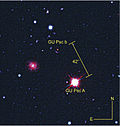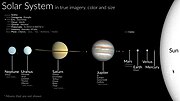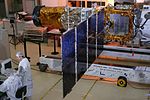Exoplanetary Circumstellar Environments and Disk Explorer (EXCEDE) is a proposed space telescope for NASA's Explorer program to observe circumstellar... 9 KB (321 words) - 20:23, 15 January 2024 |
 | A circumstellar disc (or circumstellar disk) is a torus, pancake or ring-shaped accretion disk of matter composed of gas, dust, planetesimals, asteroids... 24 KB (2,947 words) - 02:11, 14 March 2024 |
 | out of a nebula to create a young protostar orbited by a protoplanetary disk. There are eight planets within the Solar System; planets outside of the... 8 KB (781 words) - 19:19, 18 April 2024 |
Retrieved 14 January 2024. "The TOLIMAN mission: precision astrometry for exoplanetary discovery in the solar neighborhood" (PDF). Archived (PDF) from the original... 21 KB (1,185 words) - 12:48, 19 April 2024 |
 | Disrupted planet (category Circumstellar disks) of related gas, dust and debris, which may eventually surround the parent star in the form of a circumstellar disk or debris disk. As a consequence, the... 15 KB (1,423 words) - 07:51, 18 March 2024 |
 | Kepler-1649c (section Mass, radius and temperature) has a mass 1.2x times that of Earth, and has a radius of around 1.02 times that of Earth. Based on its mass and radius, it is likely a terrestrial planet... 10 KB (885 words) - 21:09, 14 January 2024 |
may refer to: Ceftiofur, a chemical compound Exoplanetary Circumstellar Environments and Disk Explorer, a planned space telescope This disambiguation... 168 bytes (49 words) - 11:19, 28 December 2019 |
Exozodiacal dust (category Circumstellar disks) grains of amorphous carbon and silicate dust that fill the plane of extrasolar planetary systems. It is the exoplanetary analog of zodiacal dust, the... 8 KB (914 words) - 14:45, 23 March 2024 |
 | Astronomy and Space Science Institute and the Spitzer Space Telescope. Initially, it was believed the planet has a mass similar to Earth and is located... 7 KB (435 words) - 16:57, 16 January 2024 |
In Evans, Christopher J; Simard, Luc; Takami, Hideki (eds.). Ground-based and Airborne Instrumentation for Astronomy VI. Vol. 9908. pp. 99086T. arXiv:1606... 23 KB (1,494 words) - 20:34, 3 February 2024 |
 | LHS 1140 (category Gliese and GJ objects) arc annually. The star is over 5 billion years old and has only about 18% the mass of the Sun and 21% of its radius. LHS 1140's rotational period is 130 days... 13 KB (1,018 words) - 00:15, 12 January 2024 |
 | Sarah Ballard (category Official website different in Wikidata and Wikipedia) Torres Fellow at the Massachusetts Institute of Technology, a L'Oreal Fellow, and a NASA Carl Sagan Fellow. Ballard was part of a collaborative team that was... 17 KB (1,233 words) - 05:14, 4 April 2024 |
 | Kepler-1647b (section Mass and orbit) using the transit method, when it caused the dimming of the primary star, and then again of the secondary star blended with the primary star eclipse. The... 8 KB (628 words) - 01:59, 14 April 2024 |
dwarf desert is the signature of different formation mechanisms for stars and planets, the extremely close proximity of OGLE-2016-BLG-1190Lb to this desert... 5 KB (359 words) - 03:07, 22 December 2023 |
 | star GU Piscium, with an extremely large orbit of 2,000 AU (3.0×1011 km), and an apparent angular separation of 42 arc seconds. The planet is located at... 8 KB (674 words) - 20:06, 22 December 2023 |
kilometres (20,000 mi) in diameter and 12 times as massive as Earth. It was discovered by the NASA Kepler spacecraft, and is the first exoplanet discovered... 7 KB (330 words) - 05:22, 22 December 2023 |
 | Solar System (section Formation and evolution) 658 Martin, Rebecca G.; Livio, Mario (2015). "The Solar System as an Exoplanetary System". The Astrophysical Journal. 810 (2): 105. arXiv:1508.00931. Bibcode:2015ApJ... 204 KB (20,492 words) - 18:47, 23 April 2024 |
 | Alpha Centauri (category Gliese and GJ objects) "The JWST Early Release Science Program for Direct Observations of Exoplanetary Systems I: High-contrast Imaging of the Exoplanet HIP 65426 b from 2... 113 KB (11,432 words) - 20:16, 20 April 2024 |
 | TRAPPIST-1 (section Rotation period and age) with the Atacama Large Millimeter Array found no evidence of a circumstellar dust disk. The inclinations of planetary orbits relative to the system's... 179 KB (19,770 words) - 14:21, 11 April 2024 |
 | Exoplanet (section Formation and evolution) with this method. Circumstellar disks Disks of space dust surround many stars, thought to originate from collisions among asteroids and comets. The dust... 146 KB (15,828 words) - 18:56, 20 April 2024 |
 | James Webb Space Telescope (redirect from Prime Extragalactic Areas for Reionization and Lensing Science observing program) NIRCam and MIRI feature starlight-blocking coronagraphs for observation of faint targets such as extrasolar planets and circumstellar disks very close... 210 KB (19,485 words) - 20:25, 23 April 2024 |
Meanings of minor planet names: 7001–8000 (redirect from Anders Erikson) they are given a permanent number by the IAU's Minor Planet Center (MPC), and the discoverers can then submit names for them, following the IAU's naming... 200 KB (445 words) - 18:44, 8 April 2024 |
 | CoRoT (redirect from COnvection ROtation and planetary Transits - Asteroseismology and Search for Exoplanets) store. Observed by CoRoT during an outburst of matter towards its circumstellar disk, which is typical of such stars, its frequency spectrum suffered drastic... 127 KB (13,953 words) - 05:00, 10 April 2024 |





